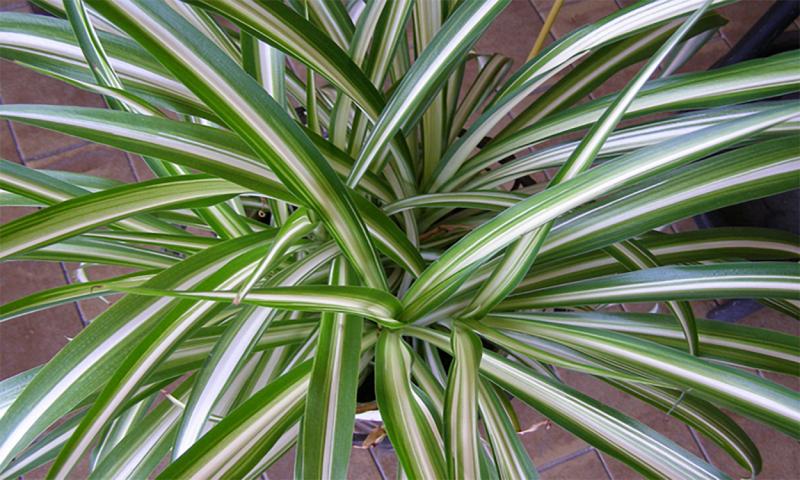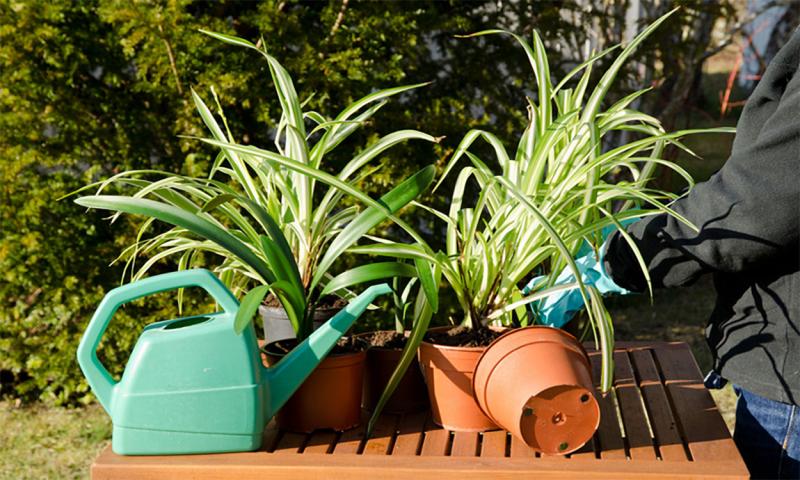Written by Cindy Schnabel under the direction and review of Kristine Lang, Sydney Trio, and Robin Buterbaugh.
The spider plant (Chlorophytum comosum) is one of the most-common and popular houseplants. The name may seem a bit scarry, but don’t let that fool you. This plant is easy for beginners and seasoned gardeners to grow. The spider plant originated in the jungles of South and West Africa. It is a member of the Asparagaceae family. Later in the 18th century, it was introduced into Europe. In some regions, variegated varieties were called the ribbon plant.
Description

- Appearance: The plant produces long, twelve-inch leaves that look as if they were folded in the middle. Groups of leaves emerge from a fleshy root system. Stems can grow up to two feet long and produce small, white, star-shaped flowers at the end. Blooms occur in response to short days and long, uninterrupted nights for at least three weeks. If the flower is pollinated, a leathery, three-angled capsule containing flat, black seeds may form. If not, the plant has the unique ability to produce “spiders,’ “babies,” or offshoots. These are small versions of the main plant with roots already established. This distinctive trait gives the plant its name.
- Types: Spider plants can be in groups of three distinct categories. Green spider plants have long, deep, green leaves. Variegated spider plants, which are the most common, show off different foliage colors. The leaves are green with patterns of white that can be striped or spotted looking. There is even a purple variegated variety. Third and the hardest to find, are curly leaved spider plants. These have variegated leaves that look crinkled.
Plant Care

The spider plant is easy to grow, because it grows in a wide variety of conditions.
- Soil and Repotting: General purpose potting soil. The plant likes to be root bound and will produce babies when root bound. However, if left too long, it can crack the pot or container and would need to be repotted in general potting soil. It is advisable to wait four to six months before you feed a newly potted plant.
- Water: Water once a week, allowing the soil to dry out between waterings.
- Light: Indirect to moderate light.
- Temperature and Humidity: Temperatures that are 65 to 75 degrees Fahrenheit during the day and 50 to 55 degrees at night. Average humidity.
- Fertilizer: Fertilize the plant every three to four months.
- Propagation: Propagating spider plants is very simple. You can remove one of the offshoots and directly plant it in potting soil. Or you can place the offshoot in water for a couple of weeks. This will encourage more root growth before planting it in soil medium.
Problems and Solutions

Depending on the conditions, some spider plants might show signs or symptoms of a few different issues.
- Pests: In some cases, pests, like scales or mealybugs, may show up.
- Root Rot: Overwatering can bring on root rot in a spider plant.
- Browning: Browning of leaf tips is common. This is caused by low humidity, dry soil and/or chemical build up from tap water. To correct this problem, set out your water for 24 hours before using it, so the chemicals can evaporate. Then remember to water the plant regularly.
There are a few different benefits to growing a spider plant. Not only does this plant help purify the air, but it is also easy to grow, matures fast, and is a great focal point as a hanging plant.


